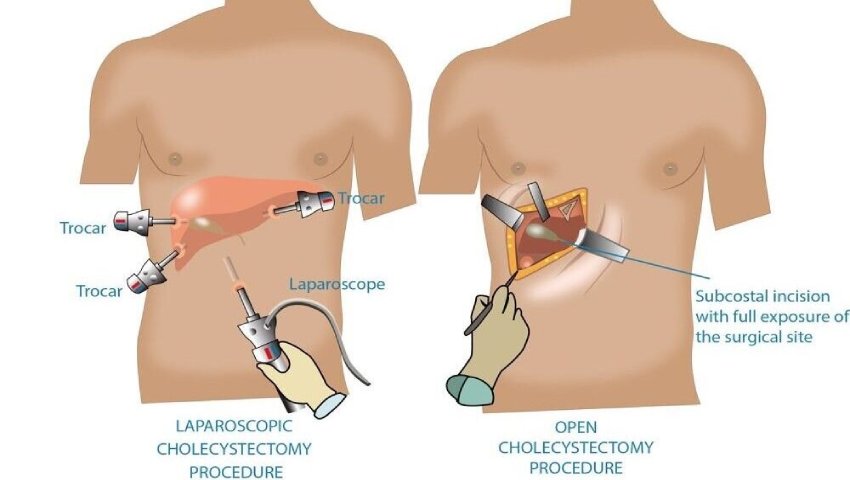
- 30/04/2025
- Dr. Samrat Jankar
- 0 Comments
- Blog
Laparoscopic vs. Open Surgery for Gallstones: Which One Is Better?
Gallstones, or cholelithiasis, are hardened deposits that develop in the gallbladder. They can vary in size and composition, often causing no symptoms initially. However, when they block the bile ducts or lead to inflammation, they can result in intense abdominal pain, nausea, indigestion, and even complications like cholecystitis, pancreatitis, or bile duct infections.
When gallstones begin to cause problems, surgical removal of the gallbladder (cholecystectomy) is often the recommended treatment. There are two primary types of surgery to remove the gallbladder: open surgery and laparoscopic surgery. With advancements in medical technology, laparoscopic cholecystectomy has become the gold standard — but is it always the better choice?
Dr. Samrat Jankar, a renowned gastrointestinal and laparoscopic surgeon in Pune, sheds light on both surgical options and helps patients make an informed choice based on their condition and needs.
Understanding Gallstones and the Need for Surgery:
Gallstones can range in size from small grains to large stones. They can block the bile ducts, causing severe pain, infections, or even inflammation of the gallbladder (cholecystitis). In such situations, surgical removal of the gallbladder becomes essential.
There are two primary methods of gallbladder removal:
- Laparoscopic Cholecystectomy
- Open Cholecystectomy
Each method has its own advantages and considerations. The decision is based on several factors like the severity of the condition, patient health, presence of infection, and previous abdominal surgeries.
What Is Laparoscopic Gallbladder Surgery?
Laparoscopic cholecystectomy is a minimally invasive procedure that involves 3 to 4 small incisions in the abdomen. A laparoscope (a thin tube with a camera) is inserted, allowing the surgeon to view the internal organs on a monitor. Special instruments are used to remove the gallbladder through one of the small incisions.
This technique has gained popularity over the years due to its many benefits.
Key Advantages of Laparoscopic Surgery:
- Smaller Incisions: Minimal scarring and lower risk of wound infection.
- Faster Recovery: Most patients can return to regular activities within a week.
- Less Postoperative Pain: Patients experience less discomfort compared to open surgery.
- Shorter Hospital Stay: Many patients are released within 24 hours.
- Better Cosmetic Outcome: Scars are less noticeable.
What Is Open Gallbladder Surgery?
In open cholecystectomy, a single, larger incision (about 5 to 7 inches) is made on the right side of the abdomen to access and remove the gallbladder directly.
This approach is typically advised in complicated cases, such as:
- Severe gallbladder infection
- Extensive scar tissue from previous surgeries
- Obesity or bleeding disorders
- When the laparoscopic approach is not possible or safe
Pros of Open Surgery (in specific cases):
- Better Access for Complex Cases: Offers a broader view and direct access, which is important in severe infections or anatomical anomalies.
- Preferred During Emergencies: In case of uncontrolled bleeding or unexpected complications during laparoscopy, surgeons may convert to open surgery.
Which One Is Better?
According to Dr. Samrat Jankar, laparoscopic surgery is the preferred choice for most patients with uncomplicated gallstone disease. It offers a quicker, safer, and less painful recovery process.
However, in certain high-risk or emergencies, open surgery may be the safer and more effective option.
Here’s how Dr. Jankar advises patients to approach the decision:
- Listen to Your Surgeon: Every patient’s condition is unique. Your surgeon will advise the best approach based on your medical history, test results, and intraoperative findings.
- Consider the Benefits of Minimally Invasive Surgery: If you are eligible, laparoscopic surgery provides faster recovery, less pain, and better cosmetic results.
- Don’t Fear Conversion to Open Surgery: Sometimes, what starts as a laparoscopic surgery may need to be converted to an open one. This decision is made in your best interest to avoid complications and assure complete recovery.
What to Expect After Surgery?
Recovery After Laparoscopic Surgery:
- Return to light activities within a few days.
- Resume a normal diet in 1–2 days.
- Mild pain or bloating is common initially.
- Full recovery in about 1–2 weeks.
Recovery After Open Surgery:
- More pain and restricted mobility in the first week.
- The risk of complications like hernia or infection is higher.
- Full recovery may take 4–6 weeks or more.
Conclusion:
Both laparoscopic and open gallbladder surgeries are effective methods to treat symptomatic gallstones. While laparoscopic surgery is less invasive and offers faster recovery, open surgery still plays a vital role in complex or emergency situations.
The best approach depends on individual patient evaluation, and decisions should always be made in consultation with an experienced gallbladder surgeon in Pune. At Kaizen Gastro Care, Pune, Dr. Samrat Jankar and his team use cutting-edge diagnostic tools and surgical techniques to ensure patients receive the most effective and safest treatment possible.
If you or a loved one is dealing with gallstones or gallbladder issues, consult with Dr. Samrat Jankar at Kaizen Gastro Care, Pune, to understand your best surgical options. Your health and comfort are always the top priority.
